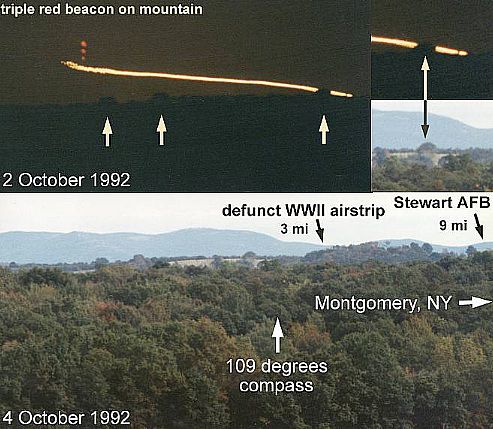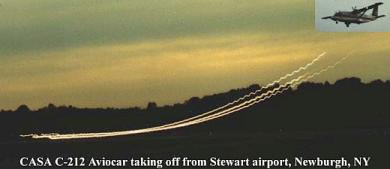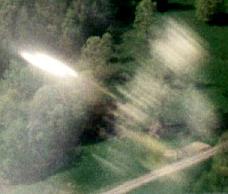Mystery C-5 from Stewart AFB
by Bruce Cornet, Ph.D.
| On 4 October 1992 Bruce Cornet went to Stewart International Airport to photograph aircraft with navigation lights on at dusk. He witnessed and photographed a C-5 military transport aircraft disappear and then reappear as it landed at Stewart Air Force Base near Newburgh, NY. | 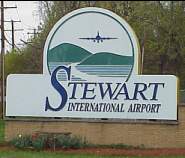 |
He photographed this extraordinary event just outside the perimeter of Stewart International Airport at the end of the main runway (pictures below). Immediately after taking five pictures of the C-5 landing, red lights began to flash and a military police jeep sped down the runway access road to identify who had photographed the aircraft. After MPs saw Cornet, they returned to their base at the other end of the airfield. Soon thereafter a New York State trooper pulled up and stopped his car by Cornet's vehicle. He walked up the hill to where Cornet was standing, and asked him for his ID. He asked Cornet why he was taking pictures. He then told Cornet that taking pictures of aircraft at the airport was prohibited. He did not specify military aircraft. Stewart airport is a joint civilian and military facility (combined Army and Air Force bases).
Puzzled by this statement (Cornet had been to Stewart airport numerous times to photograph civilian and military aircraft without anyone objecting), he asked the trooper where he could go to get permission. The trooper told him to go to airport administration and security. Cornet drove over to the airport and asked an official in administration if he could take photographs of aircraft. He was told, "Yes," and that he could park alongside the perimeter fence and take as many pictures as he wanted.
That series of events raised a number of questions in Cornet's mind, especially since he had observed and photographed the same C-5 circling above the area where he and two other witnesses had seen an AOP descend and disappear two days earlier. In order to understand the extraordinary circumstances involved, and why Air Force security became bent out of shape when Cornet photographed something he shouldn't have, the sighting on the night of 2 October 1992 will now be described.
AOP
Descends and Disappears into a Farm Field
[separate window]
On 2 October 1992 Fred Brock, Evelyn Brock, and Bruce Cornet witnessed an AOP descend below tree top level three miles away from their observation station on Muddy Kill Lane, Montgomery, NY. They had climbed up to the foundation of a new home on a low ridge overlooking the Wallkill River valley in order to skywatch. At 10:45 pm they notices a golden yellow light approaching from the east over Walden, NY. It turned south (to the right) and began moving towards the town of Montgomery. Because of its relatively low altitude for a plane at night, Cornet began to take a series of time exposures. Its speed or movement was erratic. As Cornet opened the shutter for several of his time exposures, the light sped up, then slowed down. As it passed due East in front of the triple red beacon on the mountain across the valley, the AOP rose in altitude as it slowed to a near stop, then tilted downwards, and began to descend at a 7 degree angle as if on a landing approach (Fig. 6).
|
The AOP passed behind a couple trees and disappeared below tree top level in the direction of 109 degrees compass. The Brocks and Cornet drove towards the area where it disappeared, only to discover that it went down on the east side of the Wallkill River. Evelyn briefly saw a set of lights hovering just below tree top level in the direction where it disappeared. By the time we stopped and turned around, the lights had disappeared.
Two days later on 4 October Cornet drove over to the area where it had gone down after spotting the field it disappeared in from the house foundation they had witnessed the event. Cornet had with him the developed pictures, so that he could pinpoint the location and take photographs of the area during daylight.
Cornet discovered that an old World War II airfield, now converted to an 18 hole golf course, lay just south of where the AOP disappeared. If that airfield were still active and didn't have huge trees growing on the old runways, what they had witnessed several days earlier could easily have been dismissed as an aircraft on landing approach to that airfield. That is because the main runway was oriented north-south, in the direction the AOP had traveled.
C-5 Circles above Cornet
As Cornet looked for any signs of vegetation disturbance in the field (he found none), he noticed a C-5 military transport aircraft circling above him. He took two pictures of it circling, one of which is figured below (Fig. 7).
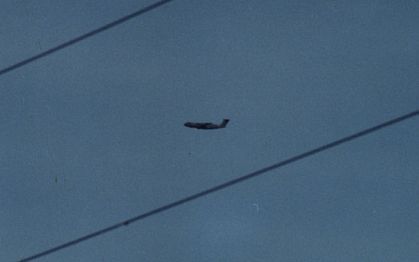
Sunset was approaching. Before Cornet quit for the day he decided to go to Stewart International Airport and photograph commercial aircraft landing at dusk. He wanted to photograph them with their navigation lights on, so that he had both a record of the type of aircraft, and the type of light pattern it had. Instead of going to the main terminal and photographing aircraft through a high wire fence, he decided to locate the end of the main runway, and find a suitable place outside the airport to set up his camera and tripod.
He found a road that passed directly beneath the end of the runway, which was situated on a hillside. A large grass-covered hill lay to the north side of runway 109, which is oriented east-west. It is there that he began taking pictures of commuter planes landing just before sunset.
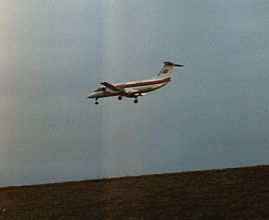
After several commercial aircraft landed, he heard the distant sound of a C-5 as it approached the airport. He hadn't photographed a C-5 before landing, so he made sure the camera was working properly and he had advanced a new roll of film enough. Because the Sun was low on the horizon to the right of the picture, he had to reduce the f-stop or aperture, which slowed the shutter speed down to about an eighth or a quarter of a second. Then he saw something large approaching from the south. As the C-5 came into range of his camera, he snapped a picture. But as soon as he had taken the picture, he could not see the C-5 anywhere (Fig. 8).
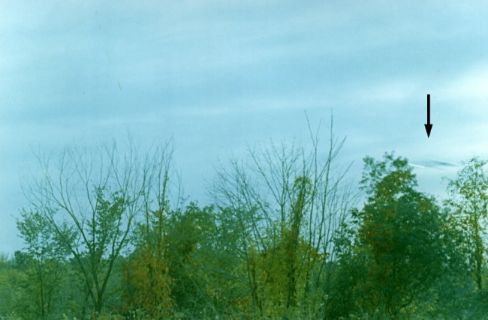
The photograph below shows an enlargement. Only a blurred portion of the left wing and one navigation light can be seen. The entire fuselage, tail, and right wing are not visible in the photograph (Fig. 9).
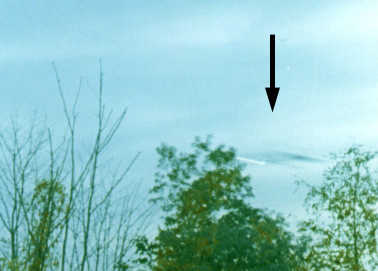
Cornet's initial reaction when he saw the photograph was that he didn't have the aircraft inside the range of the camera. But he remembered seeing the aircraft disappear.
Moments later the C-5 reappeared, but now much closer to the runway. Cornet rotated his camera and took another picture, this time capturing the C-5 well within the picture frame. When he examined this photograph, he was puzzled. The image did not show normal motion blur. In addition, the C-5 appeared as if it were a shadow. It was coal black in color (Fig. 10).
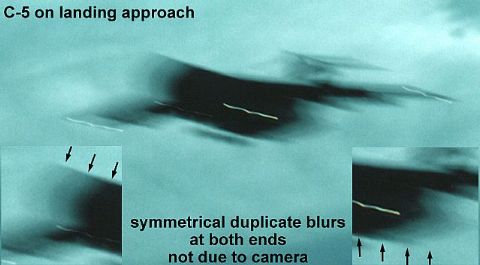
Based on the movement of navigation lights, it is clear that this photograph was taken as a slow speed. Blurring should have occurred only in back as the C-5 moved forward. But there is no blurring. Instead, a silhouette of the aircraft's shape is replicated in discrete steps, each becoming darker as it gets closer to the center of the image. In other words, the image of the aircraft is expanding in length and breadth in pulses, while absorbing any light that reaches the airframe. This is what one would expect for a contracting energy field around an object, if that energy field was capable of bending light or causing light to wrap around the airframe.
Take a look at the negative and the sequence of images taken (below). In image #3 there is no aircraft. In image #4 the C-5 appears on the right side, but it is mostly invisible. In image #5 the C-5 is visible, but it does not appear normal. In image #6 the C-5 is clearly visible, but it still has blur both in front and in back. It is also lighter in color (not as black). Details of its engine pods and stabilizers can be made out now, whereas before they could not (Fig. 11).
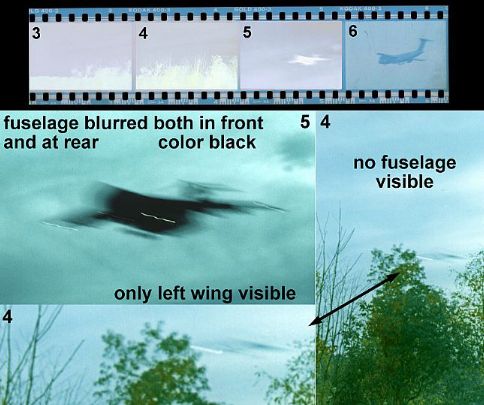
Figure 12 below shows image #s 6, 7, and 8 on the film (numbers present on the negative). In each of these images the amount of apparent blur decreases, as the color becomes lighter. In the last image showing the C-5 on the runway, the multicolored camouflage paint on the airfame can be seen clearly (Fig. 12).
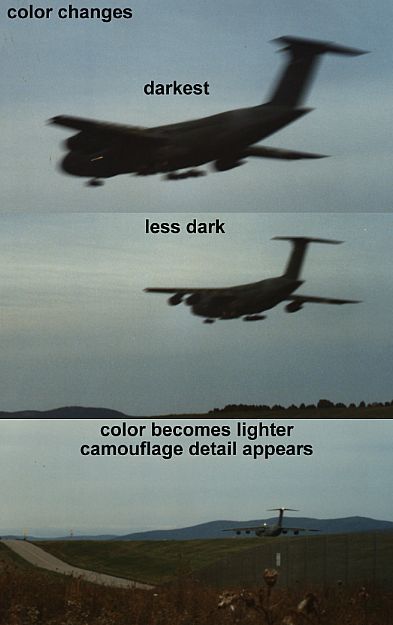
Soon after the C-5 landed and came to a stop, a military jeep containing MPs sped down the access road seen on the left, and stopped opposite Cornet, who was on the other side of a wire fence (barely visible in the last image).
Interpretation
As the C-5 landed, it slowed in speed rapidly, accounting for some of the decrease in motion blur. However, in Figure 10 the fact that step-like blurring occurs both in front and in back of the fuselage, along with significant light absorption, implies that something else was happening. The fact that only a portion of the airframe is visible in Figure 8, which should not have been the case (same camera, same shutter speed, same f-stop), implies that something else was happening. The fact that soon after the C-5 landed MPs attempted to identify who had taken pictures implies that something else was happening. The fact that a New York State trooper was called in to investigate and get Cornet's ID, and that he was told to tell Cornet that taking pictures of aircraft was prohibited, implies that something else was happening. What's the big deal taking pictures of C-5s, which can be seen parked on the tarmac across from a commercial terminal (Stewart AFB is a C-5 training facility)? The fact that an airport official told Cornet later that same night that there was no ban on taking pictures of aircraft at the airport implies that something else was happening.
So what was happening?
In recent months George Filer has been getting a number of reports from witnesses, who have seen aircraft producing unusual contrails (chemtrails), which then suddenly disappear.
Filer's Files #31 -- 2000, MUFON Skywatch Investigations
George A. Filer, Director, Mutual UFO Network Eastern
August 7, 2000, Majorstar@aol.com, Sponsored by Electronic Arts
Web Site at: http://www.filersfiles.com.-Chuck Warren Webmaster.
On July 17, Georgia State Director Tom Sheets who is also a retired Chief of Police and two other high quality witnesses driving into Tennessee noticed an aircraft spraying contrails. At the apparent end of the contrail the aircraft conducting the spraying operations suddenly disappeared. This has been reported throughout the US and in several other countries. Frequently, there are several aircraft involved in the spraying operation. Many witnesses also report seeing hockey puck-like objects or disc shaped UFOs near or inside the spraying activity. I personally have 5000 flying hours and have often seen contrails formed when we flew near or above 30,000 feet. Essentially, these contrails are condensed water vapor. On July 3, I saw an aircraft making heavy dark looking contrails that appeared quite different from standard. They may have powder or impurities in them that may come from the new jet fuels. The most amazing thing that occurred is that when the spraying stopped the aircraft disappeared. I searched the clear blue sky with binoculars but no craft could be observed. An aircraft simply does not vanish from a clear blue sky unless it has active camouflage or crashes. One possible way for an aircraft to vanish would be to use a liquid screen similar to one used on a typical lap tap computer. If hundreds of liquid screens were mounted on the underside of aircraft it could be made to seem to vanish by videotaping the sky above the aircraft and applying this same color to the liquid screens covering the aircraft. To the naked eye the craft would disappear.
